Ceramic watches – will go through fire and water
Ceramics has come in sight of modern watchmakers not long ago. Being an experimental material and a mere sample for designers and engineers of big companies, that material could take a completely special place among watchmaking materials. One of the first companies that became an innovator in the use of ceramics was Rado, which brought that popularity to the world watch market. Then the idea was taken up by such companies, as Chanel, Dior and Lancaster.
Today ceramic watches are a real trend that many watch companies try to realize. However, still only some of them are leaders in the manufacture of ceramic watches.
History of ceramics
.jpg) The history of ceramics is interesting and various, depending on the place and region of its appearance and development. The word “ceramics” comes from the Greek word “κέραμος”, which means “clay”. The history of this material, as well as of many others, roots back in the great antiquity. According to scientists, ceramics is one of the first materials created by man. Ceramics appeared in the epoch of mesolite and the late Stone Age. Ancient ceramics represented a simple pot with earthy and porous crock. The historical ceramic items are distinguished by hardness and porosity. The history of ceramics is interesting and various, depending on the place and region of its appearance and development. The word “ceramics” comes from the Greek word “κέραμος”, which means “clay”. The history of this material, as well as of many others, roots back in the great antiquity. According to scientists, ceramics is one of the first materials created by man. Ceramics appeared in the epoch of mesolite and the late Stone Age. Ancient ceramics represented a simple pot with earthy and porous crock. The historical ceramic items are distinguished by hardness and porosity.
Household items were the first things that man started to create from clay. At the dawn of civilization ceramics was mainly used as a material for making crockery: in fact, ancient ceramics represented usual clay, but in antique times fictile art represented a mixture of clay and mineral supplements, which changed the properties of clay according to masters’ needs. Initially ceramics was made by hand. And only in the third millennium B.C. the potter’s wheel that allowed making crockery with thinner walls was invented. Different kinds of clay and various admixtures made completely different and unique items. In effort to obtain a beautiful and solid material – thin and strong ceramics, people experimented much with different kinds of clay, its mixtures, molding and baking methods, adornment of items.
Household ceramics was improved with the development of humanity: punched or engraved (such finishing was especially specific for the Greek ceramics or Roman “Terra sigillata”) or color-glazed (that method appeared in the Renaissance, the so-called “Hafner ware” of Renaissance). The main kinds of ceramics are majolica, terracotta, faience, and porcelain.
In Middle Ages the Europeans used ceramics mainly for making crockery for food storage. The craftsmen used different materials: white sand, white clay, rock crushed crystal. After painting and baking the items were glazed and baked again.
The end of XVI century in Europe was marked by the appearance of majolica – faience. However, the secret of obtaining faience was known even to the craftsmen of Ancient Egypt in the 15th century B.C., and later in the 3-4 centuries faience was again independently invented in China, but the Europeans learned that secret only in the 18th century.
In the XVI century Germany started the manufacture of ceramic stoneware. So, in Siegburg white ceramics was popular, and in Rehren – painted ceramics. A quite strong crock consisted of clay, mixed with feldspar and other materials. Baking changed that kind of ceramics into solid and practically nonporous material. And in Holland, for example, red ceramics was made, the sample of which was taken from Chinese ceramics.
In England the history of ceramics started in the first half of XVIII century, however, the contribution of the European masters is also rather great: so, the craftsmen of France and England created their own kinds of porcelain. So, soft porcelain or bon china became a peculiarity of European culture.
***
Different craftsmen from different epochs tried various sorts of clay, various techniques of painting, various colors and production methods. Today many people collect ceramics as historical monuments of art culture. However, in the modern world ceramics has become a rightful industrial material, used in instrument-making, mechanical engineering, aircraft industry, etc. Ceramics is also used as a building and art material, in medicine and science, and recently it has deserved careful attention of the watchmakers. And it’s not for nothing. This material has all necessary features to be applied for making watches: durability, electromagnetic-resistant and hypoallergenicity.
Ceramics: hypoallergenicity is guaranteed
Only one fact proves uniqueness of ceramics: thermal protection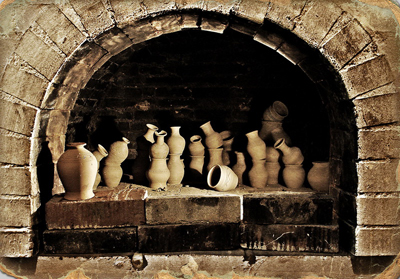 of space shuttles is made of this material. Ceramics prevents the spacecraft from burning in the atmosphere indeed. of space shuttles is made of this material. Ceramics prevents the spacecraft from burning in the atmosphere indeed.
Ceramics: stable shortness
Of course, many of you can justly notice that ceramics is a short material, which can be easily damaged. Well, it’s true, ceramics is not steel or titanium for sure. However, the seeming shortness, in fact, is not so short, as it turns out. The modern technology achievements reduce pressure and shortness degree of ceramics thanks to various methods of processing and addition of other ingredients, making the material stable and durable and providing long life of your reliable chronometer.
However, if you once decide to toss up ceramic crockery within reach, the ceramic watches are not the best instruments to beat off the wall. Nobody promises you such durability.
Kinds of ceramics
Depending on material’s structure there are several kinds of ceramics: fine ceramics (glassy or grainy crock), including faience, porcelain and semiporcelain; coarse ceramics (coarse-grained crock), mainly including pottery. There are also boride, carbide, and silicide ceramics.
Ceramic watches
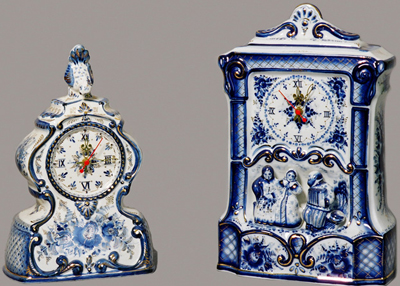 Ceramics attracted the attention of watchmakers as an interesting material for making wrist watches long ago. Ceramics is much lighter than gold and steel, lighter than titanium and other various alloys, constantly appearing at the watch market. Ceramics is a good material for any experiments. Ceramics attracted the attention of watchmakers as an interesting material for making wrist watches long ago. Ceramics is much lighter than gold and steel, lighter than titanium and other various alloys, constantly appearing at the watch market. Ceramics is a good material for any experiments.
Ceramic case is able to take original forms and distinguish by its structure from its analogues: so, one can create a ceramic case, reminding of rubber.
The ceramic watches for women became a trend at the world watch market long ago. Today more and more big watch companies refer to this material for creating expensive, stylish and accurate accessories for trend-setters. And the ceramic watches for men are an example of restrained modern classics.
Companies, making ceramic watches
There are not so many companies at the world watch market that go against general tendencies and create their original items. For a long time the watchmakers and watch companies as if didn’t decide to use ceramics. However, as soon as some big companies created several ceramic watches that became popular among experts and connoisseurs of the watch world, a new and actively developing sphere in the watchmaking appeared – ceramic watches.
Durability is not the only specific feature of ceramic watches – one of the most important peculiarities of this material is hypoallergenicity, and this means that purchasing a ceramic watch, you become an owner of item that will never provoke allergic reaction.
Today modern technologies allow watchmakers creating ceramic cases of high durability and any structure. So, mat ceramics, for example, doesn’t practically differ from modern vanguard materials, like carbon or rubber.
Ceramics in the XXI century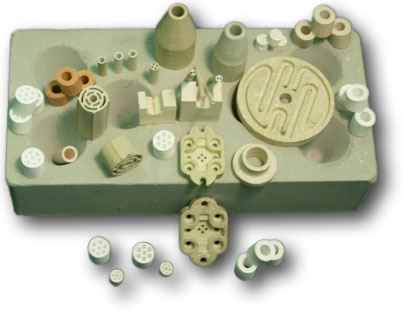
Just recently speaking about ceramic watches or simply ceramics, as a material used in the watchmaking, one could mention only the company “Rado. Just Rado was one of the first companies, which started making ceramic wrist watches with cases, similar to obsidian.
In the beginning ceramics was rather taken as exotics, and no one, even the most authoritative expert, could suppose that ceramics would become one of the most popular materials for making not only watch cases, but also movements.
Ceramics of the XXI century is a high-technological material indeed, or high-technological ceramics is a material of the XXI century. You may formulate as you like, but the watch companies are the most active experimenters today in obtaining of new alloys. So, some companies add a rare-earth metal lanthanum to ceramic powder. The obtained mixture, being processed in special furnaces at temperature of about 2000 degrees, turns into a metal, which isn’t inferior to diamond in hardness and even surpasses sapphire. So, the watches made of ceramics are practically eternal items that are afraid of neither water nor fire.
***
Rado became one of the first companies, which used ceramics in its products. After the success of ceramic watches the idea of using ceramics for making watch cases and bracelets was taken up by many designers. Today ceramics has become a worthy alternative to leather straps.
So, it’s high time we addressed to the companies, which appeared to be at the “ceramic” up-front…
Rado
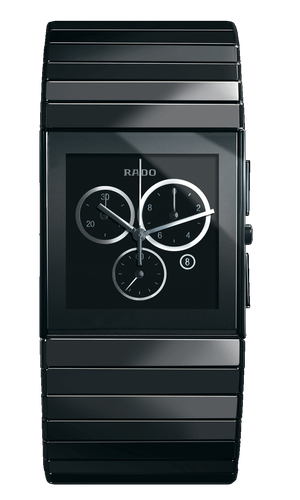 The company “Rado” can be called an eternal innovator of the watch world. Beautiful forms, functionality, and modern, sometimes vanguard design became the main features of that brand. The company “Rado” can be called an eternal innovator of the watch world. Beautiful forms, functionality, and modern, sometimes vanguard design became the main features of that brand.
The history of Rado began in 1917 in the small Swiss town of Lengnau, when three brothers Fritz, Ernst, and Werner Schlup reequipped one of their home rooms into a watch workshop “Schlup & Co”. There the ambitious brothers decided to establish the manufacture of watch movements for the North American brands. The idea was successful, and soon the hardworking Schlups managed to attract attention to their products: the movements were ordered by the American companies.
In 1947, the brothers hired Paul Luthi – a new CEO, who had a task to bring the company to the new level of the world market. Getting down to the “know-how” business, Luthi succeeded in using the contacts of Northern America, established during three decades. The list of contacts gradually widened: after war ruin the recovered markets of Germany and Japan increased the list of clients. However, the partners of “Schlup&Co” didn’t start ordering movements, but finished watches: so, in 1954 the company made its first order for a wrist watch.
In 1957 “Schlup&Co” was renamed into “Exacto”, however, such had already existed, and the brothers thought out the name “Rado”.
The next step of Rado is joining the group “SMH” (Swiss Corporation for Microelectronics and Watchmaking Industries) in 1983, which later became the core of the famous “Swiss Group”. According to many researchers, the company could hardly achieve the present success without that step.
In 1986, the company issued the model “Integral” with sapphire-sputtered case and bracelet, consisting of ceramic links. Four years later, in 1990, the company released the famous watch “Ceramica” that brought world authority of watch avant-gardist to Rado..jpg)
The engineers of the company obtain ceramics through traditional high-temperature processing of titanium carbide or zirconium carbide. The style of Rado ceramic watches, traditionally minimalistic, gets awards at the international design competitions enviably often.
One of the brand’s fans is a famous English designer Jasper Morrison, called “no-disigner” for an ability to change the appearance of things without interference in their essence. Morrison has been cooperating with the company since 2007: the recast of “Ceramica Chronograph” became the first collaboration. The designer’s variant of the model was released in a limited edition of 50 pieces.
In 2008, Jasper designed a new packing for Rado watches, then he designed an absolutely new collection “R5.5”: the name of the collection is deciphered as “radius 5.5 mm”. When the watches were issued, the critics blamed the designer for primitivism and even carelessness to the business, but the further successful sales of watches disproved any criticism. Later on the collection was reissued in renewed versions which also gained success and recognition.
Form priority, constant tendency to perfect durable case and minimalistic specific design of Rado set the movement’s role a bit. However, this shouldn’t be taken negatively: the fans of Rado don’t seem to care much about mechanical filling of the chronometer. Precision and reliability became much more important for that brand.
In 2007, the company manufactured a chronograph, which proved once again the image of Rado as a manufacturer of not classic or sport watches, but luxurious trend accessories, designed in futuristic stylle.
The chronograph from “Ceramica” series is an example of mat ceramic elegance. The bracelet, dial and counters of different diameter are made of mat ceramics. This model may seem a little bit strange for those, who are used to shiny polished classic ceramics. But this emphasizes the contrast of PVD-treated mat ceramics and steel shining bezel indeed. The watch is based on quart chronograph ÅÒÀ 251 471, the dial is covered with sapphire convex glass. The crown and chronograph buttons are made of mat ceramics, the buckle – of titanium.
Speaking about ceramic watches of Rado, we can’t but mention the model “D-Star”: this watch is ready for your beach and water entertainments. The design of ceramics watch “D-Star” for women goes a bit against the general style of Rado: D-Star – diamond incrustation and round forms of case emphasize feminity and delicacy of the chronometer.
The model “D-Star” is lack of aggravating and excessive details. The water resistance reaches 100 meters: D-Star will be perfectly good for acquiring a tan on chaise lounge, jet-skiing, yachting, and going to night clubs. The case and bracelet are made of white ceramics, adorned with 33 diamonds. The round feminine forms of the watch will be valued by all trend-setters.
Chanel
.jpg) In the beginning of XX century In the beginning of XX century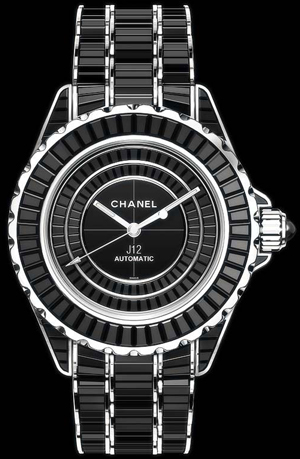 a little lady, Gabriel Chanel, stroke the world by her modern vision, embodied in her articles. She became a founder of her fashion house, which later represented a base of timeless elegance, a legendary example of haute couture and feminine luxury “Chanel”. a little lady, Gabriel Chanel, stroke the world by her modern vision, embodied in her articles. She became a founder of her fashion house, which later represented a base of timeless elegance, a legendary example of haute couture and feminine luxury “Chanel”.
Chanel manufactures clothes, cosmetics, perfumes, and, of course, the legendary French house and world trend-setter couldn’t pass by such prestigious and important accessory, as the wrist watch.
Chanel presented its first collection of wrist watches in 1987. The debut collection of “Premiere” watches literally stroke the whole world by presenting amazing and bold pieces to all connoisseurs of beauty. Chanel was the first to present multangular watches, valued by the Fashion style fans at once, to the world. During over 20 years the company has been manufacturing the wrist watches that today represent an indisputable example of elite watches.
The chronometers by “Chanel” came into the watch world from the fashion industry, therefore, unlike other watch companies, putting the technical component to the front burner, it brought matchless lightness and elegant feminine naturalness to the watch world. Innovative approach to the material choice and manufacture, and spirit of freedom are distinguishing features of this brand.
The watches from Chanel are presented in a wide range of styles: from classic and sport to baroque and luxurious. The men and women wrist watches by Chanel are manufactured in the workshops of La Chaux-De-Fonds, the cradle of Swiss quality.
Today the watch companies more often use ceramics for making wrist watches. Chanel became one of the first modern watch companies that applied ceramics in watchmaking. Choosing material, the designers and engineers followed several principles: ceramics is characterized by high degree of scratch resistance; it doesn’t provoke allergic reactions; it takes the temperature of human body; and it is comfortable for wearing. Ceramics is much lighter than silver and gold, also it is durable: ceramic articles don’t “age” or lose their chemical properties.
The company used ceramics in 2000 for the first time that became a specific revolution in the watch industry. After the successful watch collection from black ceramics in 2002 Chanel released ceramic watches once again, that time from white ceramics. Later the use of ceramics became a distinguishing feature of the brand and a revolutionary step in the world watchmaking. Besides cases and bracelets, the movement parts were also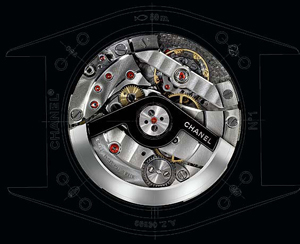 made of ceramics and modified into ceramic rotors with time. made of ceramics and modified into ceramic rotors with time.
All movements from Chanel are manufactured by legendary Audemars Piguet, which offered using ceramic details, considering the ceramic “adherence” of Chanel. However, the company makes ceramic details for its models by itself. The tourbillon, set on a ceramic plate instead of traditional l brass one and treated with rhodium, is one of such achievements.
Chanel also applied ceramics in making submarine watches. So, the water resistance of “J12 Marine” makes up 300 meters. The watch is specifically adorned with VVS diamonds, rubies, sapphires, and baguette ceramics. The limited line “J12 Haute Joaillerie” is a perfect example: its models are incrusted with diamonds and black high-technological baguette ceramics. The model “J12 Noir Intens”, decorated with black ceramics, was a star at BaselWorld 2009 and became a chase object for the collectors: the watches are issued in 5 pieces.
The base material used by the company for making ceramics is titanium carbide and zirconium oxide of 1/1000 mm granules. The powder obtained is granulated and homogenized. The samples of case and bracelet details are obtained through injection molding, then the samples are burnt in furnace at 1.450 degree temperature. As a result, ceramics acquires durability and stability.
Today, thanks to its physical and aesthetical features, ceramics has become of the most popular materials in the watch industry. More and more companies refer to ceramics for making durable and original chronometers.
Lancaster
 The rich history of Lancaster The rich history of Lancaster is famous for interesting facts. It starts in the middle of XVII century, when Dutch scientist Christian Huygens – a talented scientist, astronomer, physicist, and mathematician, recognized and respected by Isaac Newton – moved to Switzerland and established a watch company. And this is true: Huygens made a great contribution into the development of the world mechanics, astronomy, and optics. However, in spite of his fundamental discoveries, not all of his contemporaries could estimate his science achievements: Huygens was one of the first followers of Galileo’s ideas, and, of course, the Church couldn’t accept that, as at that time the science beliefs were taken as religious. is famous for interesting facts. It starts in the middle of XVII century, when Dutch scientist Christian Huygens – a talented scientist, astronomer, physicist, and mathematician, recognized and respected by Isaac Newton – moved to Switzerland and established a watch company. And this is true: Huygens made a great contribution into the development of the world mechanics, astronomy, and optics. However, in spite of his fundamental discoveries, not all of his contemporaries could estimate his science achievements: Huygens was one of the first followers of Galileo’s ideas, and, of course, the Church couldn’t accept that, as at that time the science beliefs were taken as religious.
As a result, being afraid of his life, the talented scientist had to look for a shelter in another country: he left his motherland and moved to Switzerland, which appeared to be friendlier to its citizens’ beliefs. There Huygens has written his famous essay “Horologium”, considered to be fundamental for the modern watch industry today.
Just in Switzerland Huygens designed a pendulum clock that he kept on improving within practically four decades – from 1656 to 1693 – an invention, considered to be one of the main achievements of the scientist today. Also Huygens created a pendulum clock provided with escapement, based on the principles of oscillation of physical pendulum.
In 1673, in Paris Huygens published his work “Horologium oscillatorium, sive de mota pendulorum an horologia aptato demonstrationes geometrica”, which represented a detailed description of a watch with physical pendulum. In his book the master revealed the secret of pendulum, consisting in improvements in the way of weight gain of the pendulum, making the cycloidal pendulum, which has a constant time of swing, regardless of the scale.
However, an inquisitive Dutchman wasn’t limited only by theories. And it’s not surprising, as the best watchmakers gather in Geneva, constantly designing new watches, improving movements, and creating “horlogerie” atmosphere. There Huygens opened its small watch workshop, and at that time the talented scientist was fated to meet the English engineer Edward Higgins, the watchmaker, who had come to Geneva, like many others, to improve his professional skills and do his favorite work.
The young engineers got to the scientist’s workshop as a journeyman, where in time he became one of the favorite apprentices of Huygens thanks to his talent, duty performance, perseverance, and open mindedness. Huygens bequeathed his business to Edward Higgins. Edward continued his teacher’s business with true enthusiasm and soon, thanks to his zeal, the company became a leading brand.
As the time told, the apprentice appeared to be worthy of credence the Dutch scientist had given to him. The engineer turned out to be not only a talented inventor of unique watch movements, but also a successful businessman, who managed to develop and realize a strategy of manufacture and sale of his own watches.
Higgins named his watch company in honor of his city, Lancaster. From the very beginning the watches of that brand were distinguished by stylistic design and technical component. After Higgins’ death the company ceased to exist.
The changes, happened in Lancaster in 1992, breathed a new life into the company. The company moved from Switzerland to Italy, and the manufacture processes were resumed at “Alvea” plant, which was specialized in the manufacture of “fashion” watches and which kept and developed traditions of watchmaking, established in Geneva by the Dutch scientists.
At the exhibition BaselWorld in 1997 the company successfully presented its renewed products and signed contracts with various trading houses from Spain, France, Egypt, Greece, Kuwait, Saudi Arabia, and many others… Lancaster became recognized as the best watch brand, concerning the price and quality.
The next year became crucial for merchandising of Lancaster: the company started making watches not only for elite, but also for mass part of the market, resulting in a design watch line with aluminum cases.
However, the manufacture of elite watches continued: in 2001, the diamond collection “Pillo” was issued. The watches became incredibly popular: over 10 000 timepieces from that collection were sold in Italy within only a year.
That elite line kept on widening and after a year the company completed it with the watch “Gio`Gio”. Sophisticated luxury of those watches brought great popularity, and the designers decided to go on making “precious” collections.
The following elite collections were made with the use of white and black diamonds, rubies, pink, blue and yellow sapphires.
In 2004, Lancaster struck the watch market with a silver series, and devoted the following year to the women, producing a “precious” collection in 14 color variants.
Today the watches of this company can be safely called a true embodiment of fashion and luxury. Lancaster has undoubtedly become an example of luxury. However, only a few can afford Lancaster watches: the company’s products take the highest price segment.
Today Lancaster is one of the most prestigious watch brands in Italy, characterized by highest precision of movements, vivid colors of cases and straps, original case forms, adorned with diamonds.
The company’s leadership has a quite certain point of view: everybody renews its clothes from time to time, and one and the same wrist watch can’t be used at all occasions. Dynamics and constant participation in fashion creation have become those criteria, which help the company to keep its position at the watch market.
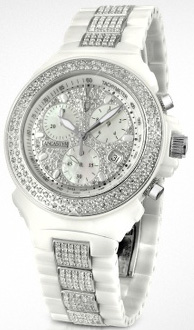 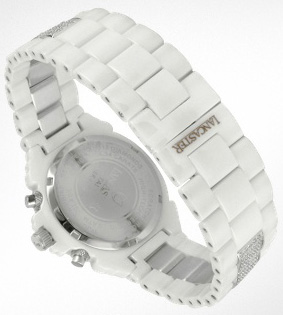 The company doesn’t follow the fashion, it creates the fashion, named “Lancaster” trend (apart from watches, the company manufactures bags and various leather accessories). It’s not easy to buy these watches today: the Italians are quite captious as for distribution. The company doesn’t follow the fashion, it creates the fashion, named “Lancaster” trend (apart from watches, the company manufactures bags and various leather accessories). It’s not easy to buy these watches today: the Italians are quite captious as for distribution.
The company has a wide range of collections: Ceramik, Luxury, Pillo, Swiss, Trendy, In Voga, Non Plus Ultra.
The company has over 100 watch models under its belt. The latest designs: ceramic watch, golden Pillila, unisex watch (platinum and golden versions), Hexagon line (men and women lines) of deluxe category. All wrist watches by Lancaster are based on quartz movements and water-resistant.
The engineers and designers work with steel, decorate dials with diamonds and cover them with mineral and sapphire glasses, the watch straps are usually made of natural leather. Recently the company has started experimenting with a quite new material, which is taking a special place in the watch industry: ceramics became a completely new discovery for the company that brought notes of fresh into the products and a new wave of original items.
The women collection “Pillo” – one of the proofs of “Made in Italy” – is a 100 per cent formula for high quality, delicate taste and skilful flair of beauty. This line is an embodiment of horlogerie traditions, luxury, imagination flight, fashion and glamour chic.
The ceramic watches “Pillo” are a sequel of “Luxury Pillo 0226HC” line, specific by their vivid colors of cases, dials and straps, and also by the “girl’s best friends” – diamonds. However, bright and cheerful colors of “Pillo 0226HC” are replaced by cold elegance of white ceramics, on the background of which the diamonds shine like a frozen and perfect ice. The precious stones of round cut proudly “throne” at bezel and even ceramic bracelet.
The model “Pillo” is a white ceramic watch-chronograph, released by the company in 2011. The combination of white ceramics and abundant incrustation of bezel, dial and bracelet with diamonds will undoubtedly provoke your sincere admiration, especially that the appearance of this chronometer is completed with the Swiss movement from ETA, specially designed for Lancaster.
Today Lancaster is at the process of its second birth, and its name is considered to be a synonym of trend design and technical progress, for which the Italian watchmakers were always famous.
Dior
.jpg) The wrist watches of the legendary Haute Couture House “Christian Dior” have set new standards and conception of horlogerie since the first day of its appearance at the world watch market in 1957. The wrist watches of Dior are full of romanticism and elegance, like the women dresses, of feminity and grace, as the women themselves. The wrist watches of this brand reflect a unique charm of feminine beauty. The wrist watches of the legendary Haute Couture House “Christian Dior” have set new standards and conception of horlogerie since the first day of its appearance at the world watch market in 1957. The wrist watches of Dior are full of romanticism and elegance, like the women dresses, of feminity and grace, as the women themselves. The wrist watches of this brand reflect a unique charm of feminine beauty.
Today famous couturier John Galliano is involved in new watch designing. He manages to combine different stylistic patterns: luxury and simplicity, elegance and boldness, classics and extravagance, sophisticated femininity and restraint. The wrist watches of Dior are pieces of art in miniature, decorating the show-windows of the best boutique and the most delicate wrists.
The watch collection by Dior is presented by several model lines. The “Christal” line is designed specifically for social animals. The watches are water-resistant and incrusted with diamonds. The “Sparkling” line is executed in “vintage” style. The watches’ straps have soft coloring, the dials are made of white mother-of-pearl and incrusted with jewels.
Dior hasn’t pass by men either: the “Chiffre Rouge” line, designed in cooperation with Zenith manufacture. The men wrist watches from Dior are performed in 3 different variants. They are equipped with automatic movements of the best quality. The watches are designed according to traditional spirit of Dior: the thread on the bracelet creates an incrustation effect and the crown is guilloched in Dior Homme style technique.
Most of Dior watch models have red inclusions in their execution. This is the brand's peculiar sign, accenting the chronometer's key elements (dates, buttons, names).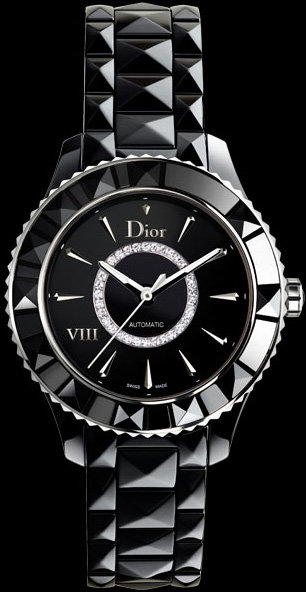
In 2008, incomparable Sharon Stone took part in the watch advertisement of Dior. But later the luxury goods retailer decided to drop the actress from its Chinese advertisements, as she provoked widespread anger for suggesting that the earthquake in south-west China was the result of "bad karma" over Beijing's occupation of Tibet. And, in spite of apologies the actress made, Dior didn’t prefer to risk and Sharon stopped presenting watches in China.
In August of 2011, the company released a new line of women wrist watches - Dior VIII, designed in three different motives: day watch “Dior VIII 33 mm quartz Dial set with diamonds”, cocktail watch “Dior VIII 33 mm quartz”, and, of course, evening watch “Dior VIII 38mm”. These watches are addressed to the ladies, who are used to look perfect and always fascinating. Therefore, Dior approached to the choice of collection’s face carefully: the advertising campaign of “Dior VIII” collection was headed by Oscar-winning actress Charlize Theron. Charlize is a faithful and old fan of the brand, and also one of the most beautiful women of her day, that’s why she became the representative of new line from Dior.
The luxurious line, consisting of three models, bears a trace of the legendary Fashion House, fully corresponding to the words by Christian Dior: “Luxury is above all a question of simplicity”. The design of watches is feminine and aristocratic; the models are made in the same manner, and the main motive is “blended” with small diamond accents, distinguishing the models from each other.
The ultrathin case made of high-technological ceramics is harmoniously combined with ceramic bracelet, consisting of small ceramic pyramids. It can be noted that such design results from architecture predilection of Christian Dior and represents a tribute of honor. From all time indexes only the marking “VIII” is left by the designers on the dial, symbolizing the number of house at the avenue Montaigne at the Place Vendome. The classic style is emphasized by an elegant black strap that became a specific “aroma” of the watch. "You can wear black at any hour of day or night, at any age and for any occasion. It is perfect. I could write a book about black." – said Dior.
The shining round black ceramic case, adorned with rhythmically repeating pyramidal ceramic ornament, became the main design accent from Dior in that line. That ornament was chosen not by chance: the black ceramic pyramids attract and catch the light, playing with luxurious light sparkles on the watches. The case diameter – 33 or 38 mm, the surface is outlined by an accented rim.
The collection “Dior VIII” is made of three parts. The first part of the collection - Dior VIII 33 mm quartz Dial set with diamonds – is budget watches, made of black ceramics and decorated with diamonds on the rim or in the center of dial. The quartz movement is the base.
The second part of “Dior VIII 33 mm quartz” is also performed with abundant incrustation of jewels. However, apart from 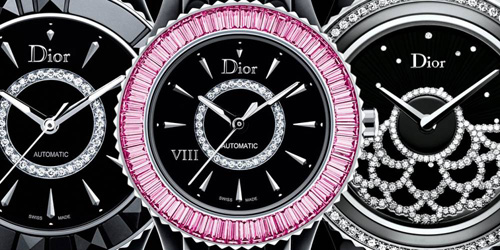 diamonds, the designers also used pink sapphires, citrines and tsavorits, which add new colors in black ceramics. The watch is offered in a small 33-mm case, covering the self-winding movement. diamonds, the designers also used pink sapphires, citrines and tsavorits, which add new colors in black ceramics. The watch is offered in a small 33-mm case, covering the self-winding movement.
The third part of the collection “Dior VIII 38 mm” represents four original models under the title “Grand Bal”, distinguished by a spectacular complication. The rotor, representing a semicircle plate, is set on the dial. It is fixed in the center and moves like a pendulum.
The plate of the first model is made of beige mother-of-pearl with grey tones. The second and third models are equipped with movable rotors, like lacy wings: the whole construction is made of white gold and white diamonds. The fourth model of “Grand Bal” is also distinguished by generous incrustation with diamonds, reminding of skilful embroidery. All wrist watches “Dior VIII” are equipped with sapphire glasses and remain water-resistant at 50 meters.
Cristian Dior is one of the brands known by practically everyone. An elite watch by Dior is a sophisticated feature of a modern man’s image, who knows the ropes in high-class pieces. Today the wrist watches are one of the main trends in the manufacture of Dior, which represents a harmonious combination of stuff’s creative potential and modern fashion tendencies.
Essence
.jpg) .jpg) The watch company “Essence” is one of the companies actively using ceramics in watchmaking. The company’s founders claim: “Time is of the Essence”. It manufactures chronometers from nontraditional alloys, combined with stainless steel. All watches of this company are provided with sapphire glassed, Swiss movements “Ronda” and batteries, guaranteeing uninterrupted movement’s functioning during 2-3 years. The watch company “Essence” is one of the companies actively using ceramics in watchmaking. The company’s founders claim: “Time is of the Essence”. It manufactures chronometers from nontraditional alloys, combined with stainless steel. All watches of this company are provided with sapphire glassed, Swiss movements “Ronda” and batteries, guaranteeing uninterrupted movement’s functioning during 2-3 years.
The watches of Asian market (Essence is a representative of this segment) are usually associated with, first of all, high technologies and moderate prices. The Korean watch company “Essence” appeared at the watch market not long ago – in 1979. The nontraditional high-technological materials in combination with popular design, based on the high-quality watch movements, became recognizable around the world and popular among those, who preferred unusual and modern things. The annual export income of the company makes up over $10 million that undoubtedly proves the brand’s popularity.
The visiting card of Essence is the use of principally new materials in watchmaking. The wolfram, titanium and ceramics cases and bracelets, for which the company is famous, look good and harmonious at the wrists, and also meet Hi-Tech trend. Besides, the used materials are durable, corrosion-resistant and hypoallergenic. Such chronometers will go through fire and water.
Ceramics, used in the manufacture of watches.jpg) “Essence”, contains “Essence”, contains(1).jpg) a rare-land metal, lanthanum, making the items ultra-durable. The details, made of this ceramics, are executed at about 20000-degree temperature and inferior only to diamond in its hardness. The ceramic details do not scratch, rust or dull. a rare-land metal, lanthanum, making the items ultra-durable. The details, made of this ceramics, are executed at about 20000-degree temperature and inferior only to diamond in its hardness. The ceramic details do not scratch, rust or dull.
Another discovery of the engineers is ceramics with zirconium oxide – high-quality material, distinguished by amazing color range and high resistance to mechanical influence.
The use of extraordinary materials enables the designers to experiment on the forms too. The design of “Essence” watches is specific by clear, strict lines, sharp straight facets. Such form guarantees the use of only high-quality and expensive materials, as cheap alloys are “rubbed away” quickly and lose their form. The fans of the company are people, attracted by everything new, extraordinary and modern.
One more advantage of ceramics is a complete “indifference” to electromagnetic waves. While a usual metallic case has a peculiarity to magnetize that in time leads to defects in the movement, ceramics is resistant to electromagnetic influence.
The company’s designers mainly follow the general style of Hi-Tech: nothing extra in the design of dials, only hour markings, strict hands and “Essence” logo. According to the watch creators, such design matches any style of clothes and doesn’t oblige an owner to a certain image. Such design’s motto is “a watch that is always with you”.
The models of Essence are mainly presented by pairs, including the men and women wrist watches with the same design. Of course, the company’s range isn’t limited by only high-technological watches from ceramics. You can also find “Essence” watches with usual traditional design.
The watches by Essence are made in Korea, but based exceptionally on the quartz movements “RONDA”, “ETA”, “ISA” from Switzerland. In August of 2010 the company adorned all its models with “Swiss Made” that speaks about accuracy, quality and durability of movements.
|


